Entertainment
After 34 years, David Hockney’s magnificent ‘Turandot’ sets get resurrected in L.A.
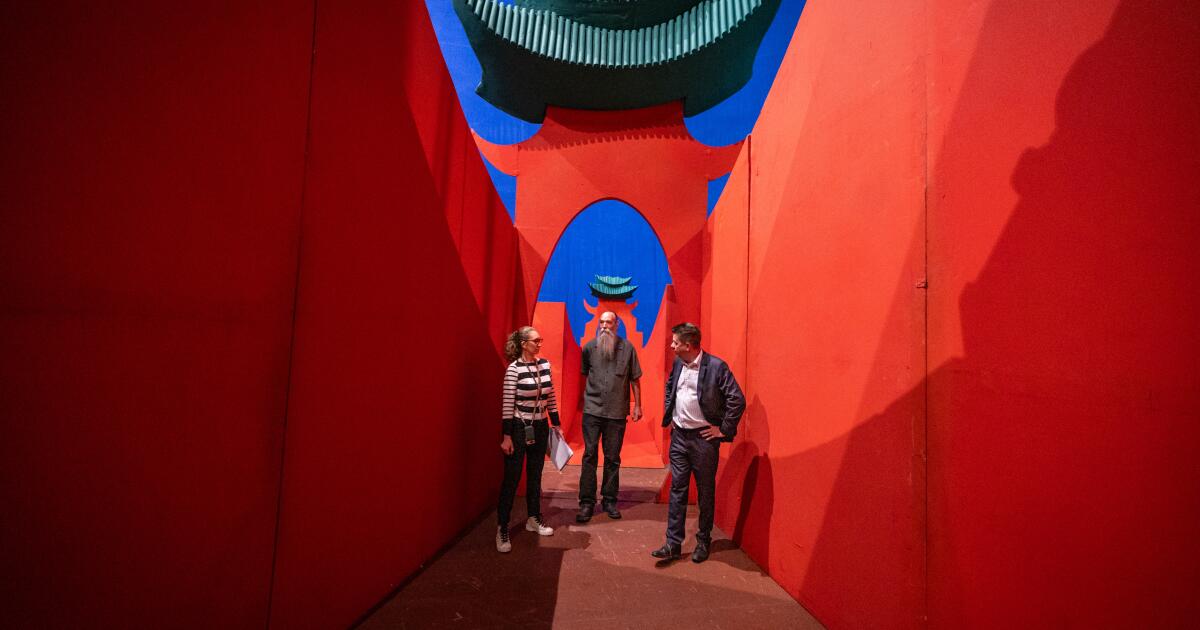
When the curtain rises Saturday evening on Los Angeles Opera’s “Turandot,” composer Giacomo Puccini’s last work will feature the L.A. debut of the production’s biggest star: monumental stage sets designed in the early 1990s by David Hockney, the renowned British painter and celebrated chronicler of Southern California life.
Bathed in deeply saturated red and ultramarine, the swooping curves and dagger-like angles of Hockney’s “Turandot” sets are the backdrop for the grim fairy tale about a cold-blooded Chinese princess who has her would-be suitors beheaded — until one of them melts her heart.
Hockney’s scenic design, reminiscent of stark German Expressionist filmmaking with a dash of the backgrounds in Walt Disney’s “Fantasia,” is a virtuosic testament to the artist’s lifelong exploration of abstract figurative painting and his abiding love of opera.
“We’ve been trying to program Hockney’s ‘Turandot’ for 30 years,” said Rupert Hemmings, vice president of artistic planning for L.A. Opera, which commissioned Hockney sets for the operas “Tristan and Isolde” and “Die Frau Ohne Schatten.” “The task is always to create something that audiences come for. It could be the soprano or the director. Here, it’s Hockney, who created a visionary work of art that the opera happens within.”
The cast of “Turandot” runs through final rehearsals Monday of the David Hockney production of “Turandot” at the Dorothy Chandler Pavilion.
(Jason Armond / Los Angeles Times)
Among the grandest of grand operas, “Turandot” is a demanding enterprise.
“There are 342 people in the cast and crew, 95% of whom are union,” Hemmings said. “To work with an 86-piece orchestra and to cast, clothe, rehearse, corral and pay 128 performers is expensive, and to protect their voices, we can only play twice a week.” With a seating capacity of 3,100 for each of six performances at the Dorothy Chandler Pavilion, he added, “it won’t even be break-even.”
In addition to the cost of personnel, L.A. Opera has spent $80,000 to rent the production assets — the props, Hockney’s sets and costumes by Ian Falconer, the writer and illustrator of the popular “Olivia” series of children’s books — from the San Francisco Opera and the Lyric Opera of Chicago, which commissioned the “Turandot” designs 34 years ago.
Having created opera sets since 1975, including 18 months of work on L.A. Opera’s “Tristan and Isolde” in 1987, Hockney took on the “Turandot” commission with fierce opinions. In his 1993 autobiography, “That’s the Way I See It,” he wrote, “I had seen many productions of ’Turandot,’ most of them kitsch beyond belief, overdone Chinoiserie, and too many dragons. … For the first scene, the city of Peking, I suggested that we take the dragons away and put them into the roofs, in forms that felt like dragons.” The result is a strikingly fantastical depiction of the city now known as Beijing, using, Hockney added, “harsh edges, strong diagonals, mad perspectives.”
According to Drew Landmesser, former deputy general director of the Lyric Opera of Chicago, Hockney — who moved to Los Angeles in 1964 — transformed a tennis court on his Hollywood Hills property into a work studio. Unlike other designers, who typically create set models at a scale of a quarter-inch or half-inch per foot, Hockney built a “ginormous platform with models so large that he could crawl around them to explore the space and how people would move in it.”
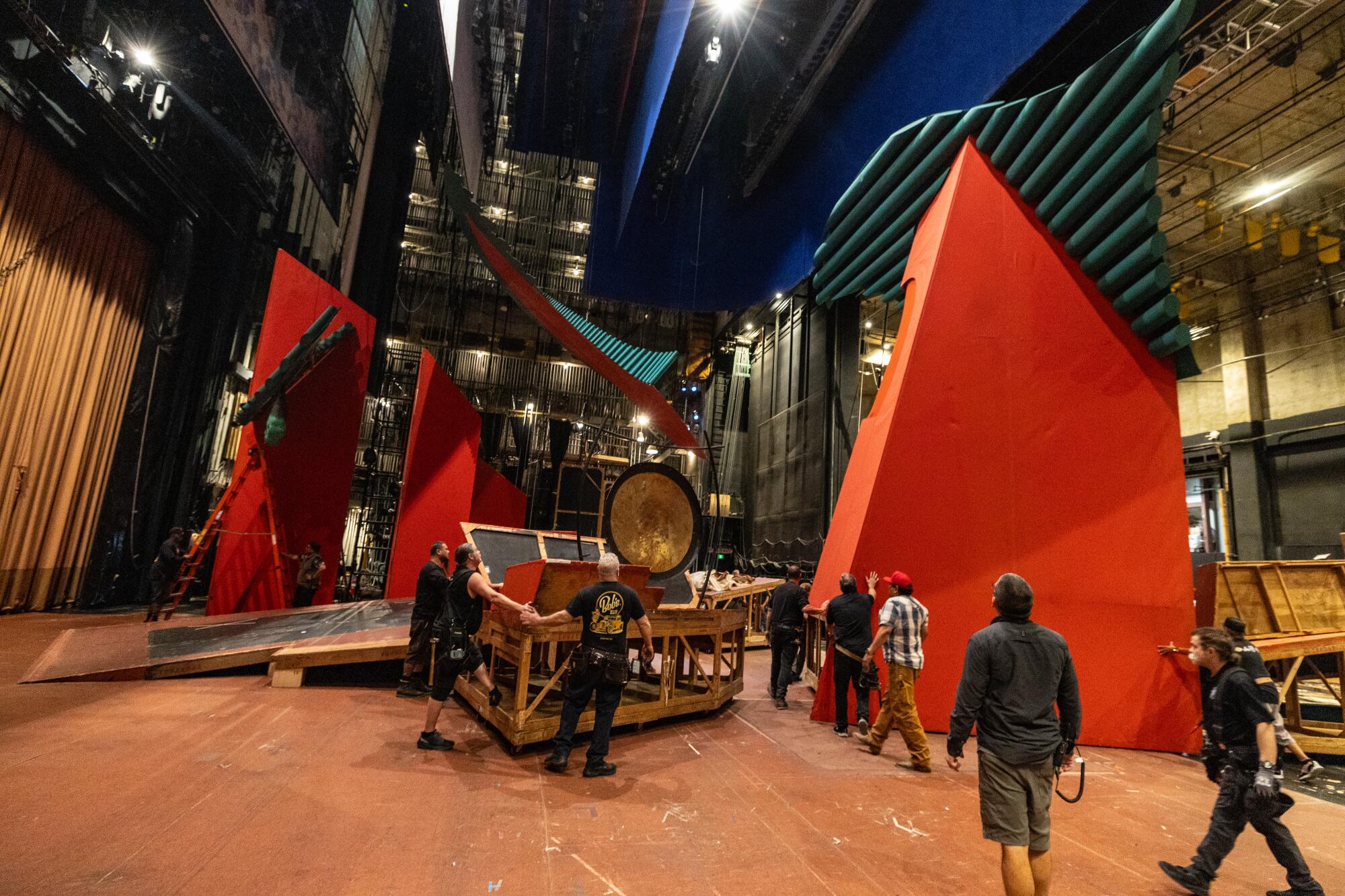
Workers move giant “Turandot” set pieces backstage for the second act during a rehearsal.
(Jason Armond / Los Angeles Times)
The artist also installed his own lighting system to ensure accurate representation of the intense colors he chose for his set pieces, which include red exterior facades that soar to 30 feet and a scrim accented with jade green and royal blue painted on seamless canvas that stretches 60 feet across the stage.
After two years of development, translating measurements for construction of the “Turandot” sets took six weeks of computer work. The sets, props and costumes cost around $1 million to produce, said Landmesser, a “not disproportionately large investment” shared by the Chicago and San Francisco companies and amortized through rentals. (That production figure does not include fees paid to the creative team, including Hockney, costume designer Falconer and the lighting and stage directors.) Since 1992, the sets have been used more than a dozen times across the U.S. and in Naples, Italy.
During a visit to rehearsals last week — as lead tenor and artist-in-residence Russell Thomas repeatedly banged an enormous gong, signifying the end of Act 1 — Hemmings and L.A. Opera technical director Jeff Kleeman described the labor-intensive process of mounting the show.
“The level of detail to produce and resource it properly takes months and months of analysis,” said Kleeman, who pores over renderings made with computer-aided design software to adapt Hockney’s design for the L.A. Opera stage and establish placement of scenic elements and lighting in what is known as a composite ground plan.
“Act by act, piece by piece, we make it fit,” he said.
The sets, which San Francisco Opera pays to store in a warehouse in Modesto, were broken down into “thousands of pieces and fit together like Tetris to reduce damage and fit into three 53-foot trailer trucks with eight-foot ceilings,” Kleeman said. Upon the sets’ arrival in L.A., his 64-strong stage crew spent five 10-hour days in three teams, sorting the pieces for each act of the opera, assembling them, making necessary repairs and positioning some 800 lights.
‘Turandot’: What to know
Three quick points about Puccini’s last opera
“The sets are what we call soft walls,” Kleeman noted, “made from wood with fabric coverings. These days, sets are constructed with steel and plywood, which are heavier and more durable. Soft walls weigh less and are cheaper to build, but after a couple of uses and trips in the truck, they tend to get worn.” Enter the scenic painters, who custom-blend and color-match Hockney’s highly saturated hues to touch up the sets and create a board lined with pieces of painted tape for quick patches before or during a performance.
Intermissions in the show last 20 to 25 minutes, to allow the 43 members of the wardrobe, wig and makeup crew to prepare performers for the next act and the stage crew to roll pre-built sets into position. About one-third of the scenery is “gripped,” Kleeman said, meaning pieces are carried onstage and assembled by carpenters. “It sounds chaotic,” he added with a smile. “Everything needs to be placed exactly where it should be, in a highly choreographed way, and with each rehearsal we refine the approach. So as big as it all seems, it becomes a routine.”

Workers move pieces of a roof during a set change.
(Jason Armond / Los Angeles Times)

Technical director Jeff Kleeman during rehearsal in the Dorothy Chandler Pavilion.
(Jason Armond/Los Angeles Times)
The towering sets are more than just spectacle, senior design manager Carolina Angulo said. “The use of forced perspective and oversize proportions unconsciously leads the audience to think about the characters’ place in this world and to feel their emotions.”
In presenting the San Francisco Opera Medal to Hockney in 2017, General Director Matthew Shilvock cited the artist for his impact on the art form.
“His productions are bold expressions of archetypal emotions, deeply rooted in a strong sense of spatial resonance and scale,” Shilvock said. “He finds rhythm in color and design and creates portals that we enter with thrilling excitement.”
Hemmings concurred, calling Hockney’s “Turandot” a provocative conceptual design that remains timeless.
“A lot of opera sets last for more than 30 years,” he noted. “If this ‘Turandot’ got to the point of it being worn out, someone would rebuild it. You would never get rid of it. That would be like throwing a David Hockney painting away.”

A “Turandot” set piece has hand-written notations about which act it’s for.
(Jason Armond / Los Angeles Times)
‘Turandot’
When: 7:30 p.m. Saturday , 2 p.m. May 26, 7:30 p.m. May 30, 2 p.m. June 2, 7:30 p.m. June 5 and 8
Where: Dorothy Chandler Pavilion 135 N. Grand Ave., L.A.
Tickets: $34 and up
Information: (213) 972-8001, LAOpera.org
Running time: 2 hours and 55 minutes (including two intermissions)

Entertainment
Tyler Perry calls out 'highbrow' critics, defends his fans: 'Don't discount these people'
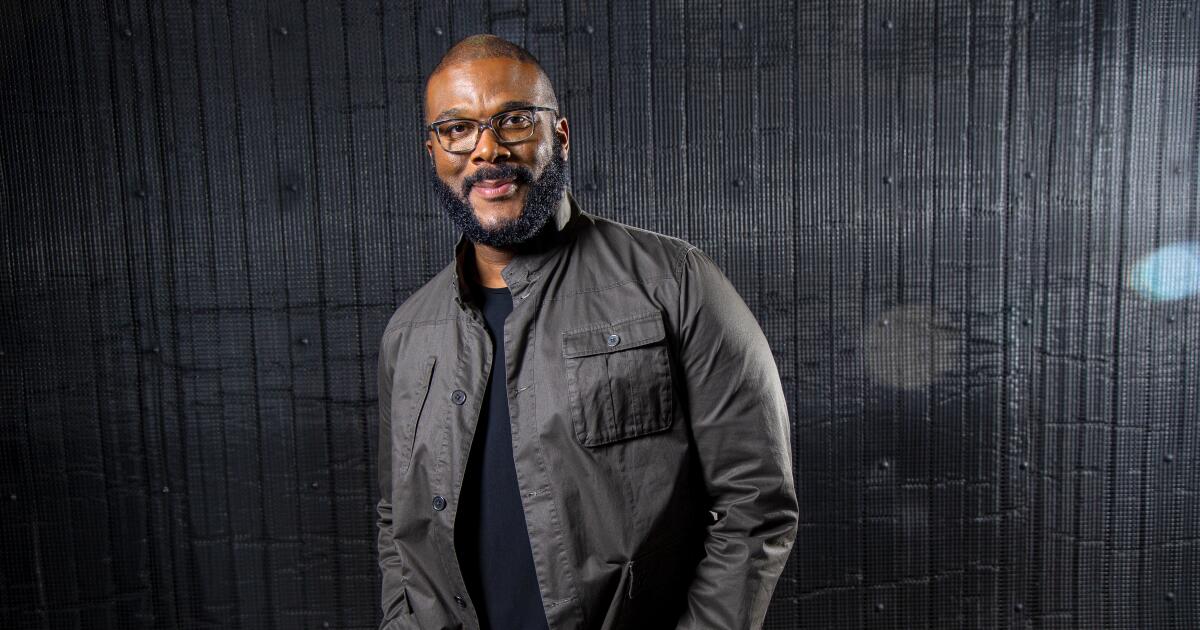
Tyler Perry’s last feature film earned a rare 0% on Rotten Tomatoes — a point that’s apparently of little concern to him.
The billionaire filmmaker, best known for his franchise character Madea, is far more interested in the opinions of his fans than those of “highbrow” critics, he said on the “Baby, This is Keke Palmer” podcast.
“For everyone who is a critic,” Perry said in the Tuesday episode, “I have thousands of — used to be — emails from people saying: ‘This changed my life. Oh, my God, you know me. Oh, my God, you saw me. How did you know this about my life and my family?’ So that is what is important.”
Critiques of Perry and his purportedly flat depictions of Black characters date back to his early directing days. Spike Lee, for one, in 2009 famously alluded to Perry’s work while complaining about the “buffoonery” in Black comedy. More recently, playwright Michael R. Jackson took his turn swinging at the movie mogul in his metafictional musical “A Strange Loop.”
In the number “Tyler Perry Writes Real Life,” Jackson’s protagonist — a Broadway usher who dreams of being a writer — denounces Perry’s oeuvre: “The crap he puts on stage, film and TV / Makes my bile want to rise!”
The song wasn’t born of any “personal vendetta,” Jackson told Washington Post Live in 2022. “It’s really about actually taking Tyler Perry’s work very seriously, because it’s often held up, often by Black communities, as sort of, like, the end-all-be-all of what one can do as a Black artist.”
“I just wanted to sort of problematize that and satirize that,” he said.
Upon Palmer referencing Jackson’s musical jab, Perry told the podcast host, “I know for a fact that what I’m doing is exactly what I’m supposed to be doing.”
When it comes to critics in general, he continued, it’s best to “drown all that out.”
“We’re talking [about] a large portion of my fans who are disenfranchised, who cannot get in the Volvo and go to therapy on the weekend,” he said. “So you’ve got this [Black critic] who is all up in the air with his nose up looking at everything, and then you’ve got people like where I come from, and me, who are grinders, who really know what it’s like, whose mothers were caregivers for white kids, and were maids and housekeepers.”
He added: “Don’t discount these people and say that their stories don’t matter. Who are you to be able to say which Black story is important or should be told? Get out of here with that bull-.”
Corey Hardict, who co-stars in Perry’s latest film “Divorce in the Black,” last week invoked a similar defense for the critical bomb: “I mean, the people love the movie and we do it for the people — that’s who I do it for. If the culture’s rocking with it, it’s all love. So it’s fine.”
Perry’s podcast comments have already garnered backlash online, with Preston Mitchum of the reality show “Summer House: Martha’s Vineyard” writing Wednesday on X, “Yes, because writing and producing a movie where a Black woman from a small town cheated on her husband, acquired HIV, then ended up physically disabled is absolutely the groundbreaking Black story we need to see.”
Mitchum’s post seemingly refers to Perry’s 2013 film, “Temptation: Confessions of a Marriage Counselor.”
Palmer defended Perry against other disparagers online, writing Wednesday on X, “The enemy isn’t Tyler it’s the system that makes it hard for multiple black artist[s] to shine at one time.”
“Tyler is not the gatekeeper of all black stories he’s just one creative who broke through the system,” she wrote. “Advocating for others to do the same is the fight, not hating Tyler for his work that many do love.”
Perry in 2019 celebrated the grand opening of his 330-acre Tyler Perry Studios in Atlanta. He created the complex with the hope of promoting cultural diversity in the film industry, he told The Times in 2016.
“Sometimes I drive around here by myself and think, ‘Is this too much, or is this what I’m supposed to do?’ ” Perry said. “The answer is obvious. When this fell into my lap, I said, ‘I have to do this.’ This is the endgame.”
Movie Reviews
Movie Review: Twisters – Kenbridge Victoria Dispatch

Movie Review: Twisters
Published 11:15 am Friday, July 26, 2024
1 of 3
Let me immediately cut to the chase (pun intended) and answer the question you’re all wondering. TWISTERS is a fun and entertaining summer blockbuster, but it in no way holds a candle to its predecessor TWISTER (1996). Still, the CGI is intense, the sound design is loud and immersive, and the lead performances — especially from Glen Powell — are sure to wow.
Following a horrible tragedy, meteorologist Kate Carter (Daisy Edgar-Jones) has spent years out of the storm chasing business. She now lives in the largely tornado-less New York City, using her innate understanding of storm systems to direct weather alerts. But when her old friend Javi (Anthony Ramos) begs her to join his privately-funded start-up, which is designed to use military-grade radars to learn more about tornadoes and save communities in Oklahoma, she agrees to give him a week of her time. It’s not too long before “tornado wrangler” influencer Tyler Owens (Glen Powell) enters the scene with his ragtag group of weather enthusiasts, creating a competition between scientific research and entertainment. Each group races to be the first on the scene, with Kate and Javi seeking to model the tornado and Tyler trying to get the most likes on social media. But can the two groups find a way to work together or will the competition be more vicious than the tornadoes?
I am admittedly judging myself for caring too much about a summer blockbuster’s plot, because that’s not really what any of us sign up for with these films. But the various encounters with tornadoes begins to feel slightly repetitive and creates pacing issues, making a two-hour film feel like its runtime. And for some reason, it seems like there is something missing when it comes to portraying the sheer terror of experiencing F5 tornadoes, unlike the original film; the main set pieces were not as memorable.
The film does little to make you care about whether the characters live or die, relying on Glen Powell and Daisy Edgar-Jones’s chemistry and natural charisma to do the heavy lifting. The second Powell steps out of his gigantic truck, with his cowboy hat and belt buckle sparkling in the sun… sorry, I just lost my train of thought… and that’s what TWISTERS is hoping. Powell’s magnetism is sure to knock you off your feet and distract you from the film’s middling plot. And while Edgar-Jones’s performance is more muted, due to her character’s battle with PTSD, she brings an important level of humanity to the film and a character to both see yourself in and root for. More than that, her chemistry with Powell is off the charts and will certainly leave you wanting their relationship explored more in a sequel. The supporting characters are not given much to work with and as such, don’t really engender much concern when they are in deadly situations.
One element of TWISTERS I liked more than TWISTER is it showed the emotional and financial toll tornadoes ravage on communities. Of course, that is an element of the first film, but TWISTERS does a great job showcasing the speed in which tornadoes can overtake and devastate a community, both in loss of life and loss of property. This, juxtaposed with the “fun” in chasing storms brings a real human element to the film. I also want to give a shoutout to the movie not having any sad animal scenes (apart from a possible run-in with a chicken). So for all of you sickos excited to see another flying cow, this isn’t for you.
TWISTERS is the exact kind of movie you need to see in a theater so you can get the full experience. Where else can you admire the cinematography, get immersed in the sound design, and lose yourself in Glen Powell’s cowboy hat and million dollar smile? I saw it in a Dolby theater and was blown away.
There is no end credit scene.
My Review: B
Entertainment
Appreciation: John Mayall set the bar for the British blues explosion by leading with heart and soul
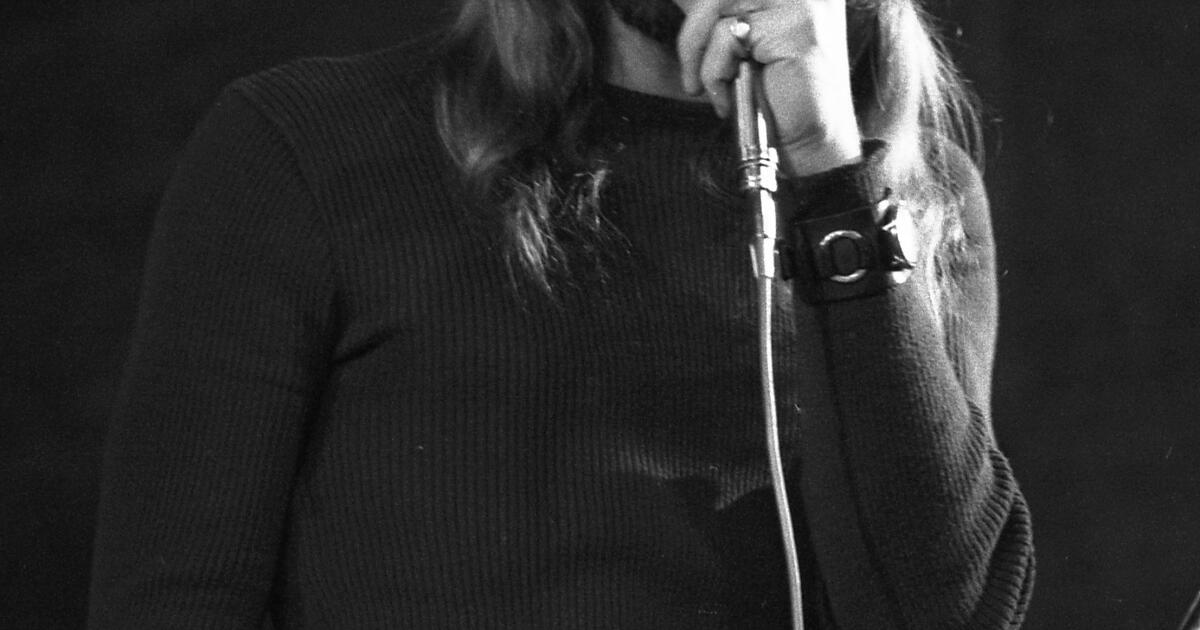
As a kid growing up on the outskirts of Manchester, England, John Mayall recognized something personal in the blues records coming over from the United States. He heard joy, agony and stories from real life, all of it set to music that could be euphoric and downtrodden, hopeful and mysterious.
It was music of profound emotion that would stay with him forever, and as a leading purveyor of that tradition in the British blues explosion of the 1960s, he represented a standard for many better-known players to follow. “He was my mentor and a surrogate father too,” Eric Clapton said in a tribute posted Wednesday on Instagram. “He taught me all I really know and gave me the courage and enthusiasm to express myself without fear or without limit.”
Mayall, who died this week at age 90, provided a home to an astonishing lineup of virtuosic players who passed through his band the Bluesbreakers en route to greater fame later: Clapton and Jack Bruce (who formed Cream), Mick Taylor (later of the Rolling Stones) and members of Fleetwood Mac, Journey, Canned Heat and more.
John Mayall was a mentor to Eric Clapton, Mick Fleetwood and many other superstars.
(Claus Hampel / Associated Press)
He was a half-generation older than many of the iconic players he nurtured, and an important source of inspiration. He gave refuge to a disheartened Clapton, who had just quit the Yardbirds and was considering leaving music entirely. But the fame that many of Mayall’s endlessly rotating sidemen later enjoyed was entirely beside the point to him.
“The great roster of the most famous names all came out of that period of London of four or five years,” he told me in 1997. “Everybody knew everybody, so they were shifting around, finding their own musical path. As a band leader I just hired whoever turned me on. That criteria is the same today as always.”
Back in the 1990s, I interviewed Mayall a few times, including at his house in the San Fernando Valley. Our very first talk on the phone was cut short by him after about 15 minutes, probably from my own inexperience as an interviewer and for asking too many questions about his more controversial statements. (Like calling Led Zeppelin “a parody of the blues.”)
But he was normally a patient proselytizer of the blues. While his own reputation often rested with his role as a profoundly gifted scout of talent, his own records showed a steady commitment to what had first inspired him. Mayall was a singer and multi-instrumentalist (harmonica, keyboards, guitar), and like his heroes, the songs he wrote were autobiographical — celebrations and laments about his life experiences.

John Mayall in 2013 at the Classic Rock Roll of Honor Awards show in London.
(Joel Ryan / Invision/Associated Press)
He was sometimes criticized as a purist who rarely wavered, even as former collaborators won accolades and made hit records by straying into rock, psychedelia and pop. If anything, his experiments went further away from the masses with a jazz-rock fusion sound on 1968’s “Bare Wires.” He stretched out with layers of horns and flute, he went solo acoustic, but the electrified Chicago blues was always his North Star.
“‘Purist’ is a funny word really, because it can mean someone who doesn’t want to shift from doing note-for-note copies of stuff other people have done in the early days,” he said. “There are bands that just do that. They consider themselves blues purists. But I’ve always been an innovator, so purist doesn’t really fit.
“I do draw from the pure roots of the blues to make something that’s very contemporary and something that is very personal.”
He grew up in the late-1940s and ’50s listening to his father’s vast record collection, learning to love the Mills Brothers, Charlie Christian and Lonnie Johnson, and was soon saving up to buy his own 78 rpm discs. “Anything with the word ‘boogie’ on it, I bought it,” Mayall told me. He then discovered the immortal blues played by Big Bill Broonzy, Blind Lemon Jefferson and Sonny Terry.
He was already 30 when he left Manchester for London, after a career in typography and art, ready to join the blues scene rising there. “It all really happened rather suddenly, and everybody really came down to London,” he said. “The Animals came down from Newcastle, Spencer Davis and Stevie Winwood came from Birmingham. If you wanted to play you really had to start off and be based in London. So that’s what I did.”
The British blues scene was kicked off by Alexis Korner and Cyril Davis, evolving from folk clubs to electrified Chicago blues. As it had for Mayall, American blues had reached the postwar generation on the British Isles and ignited a movement, even as blues was still underappreciated back in the U.S. It would take a British invasion of inspired young players to bring it back home.
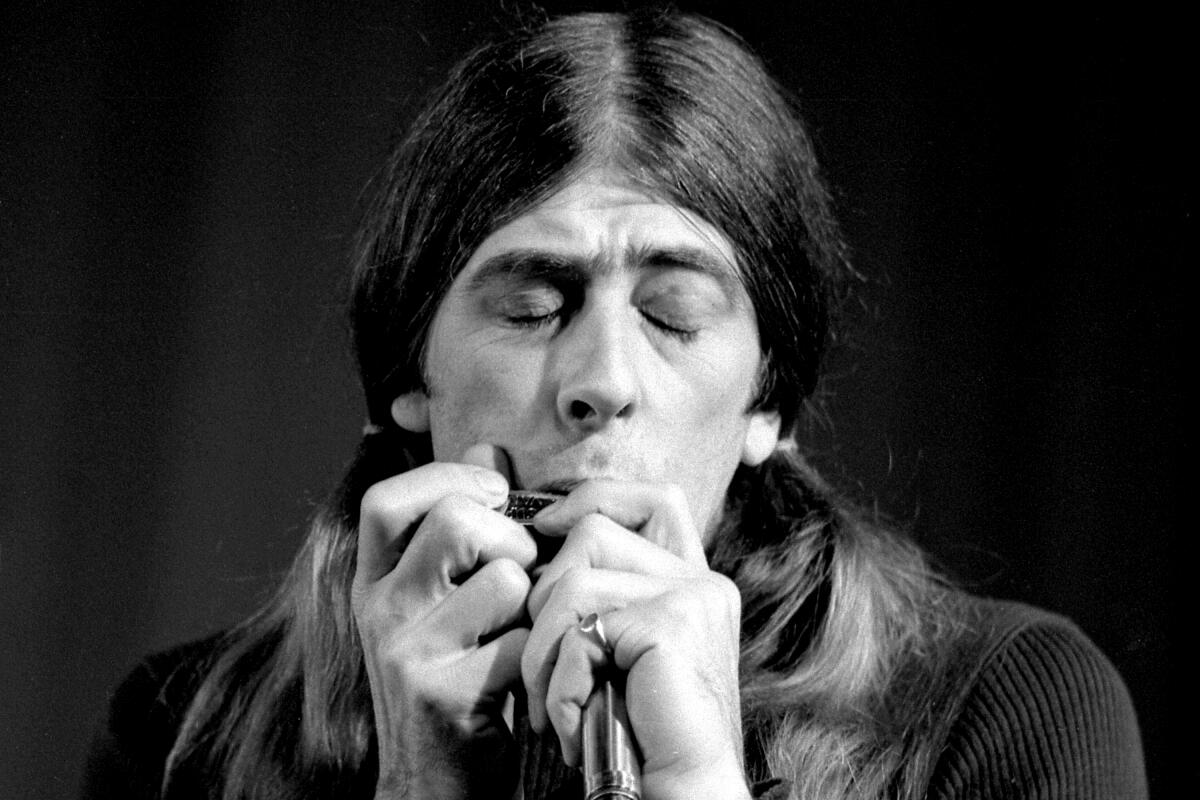
Mayall was a singer and multi-instrumentalist (harmonica, keyboards, guitar), and like his heroes, the songs he wrote were autobiographical — celebrations and laments about his life experiences.
(Claus Hampel / Associated Press)
In those early days, Mayall was encouraged by successes of the early Rolling Stones and Yardbirds. “I was pretty amazed, because I had been playing this music privately for 15-20 years and knew what it was all about. But I’d never dreamed it was fit for public consumption, so to speak,” he said. “I owed it to myself to give it a shot.”
His best-known album, 1967’s “Blues Breakers With Eric Clapton,” is considered a classic document of that scene, and an early sign of Clapton’s still evolving skills. Mayall otherwise had no major pop hits, and few accolades for most of his life other than a couple of Grammy nominations. In 2005 he was awarded an OBE (Officer of the Order of the British Empire) by Queen Elizabeth II, and this fall was to be inducted into the Rock and Roll Hall of Fame with an Influence Award.
At times during interviews, he would grumble about a lack of recognition, but his focus remained on the work ahead — spending a third of the year on the road, and releasing nearly 40 studio albums and more than 30 live recordings in his lifetime. For him, his musical journey remained always open-ended, right up until his last performance in February 2022 in San Juan Capistrano.
“Creating music is an art,” he explained. “Jazz musicians and blues musicians, their careers do not end except by death. It’s something that has a built-in longevity. It’s not a flash-in-the-pan thing. The years only make you more mature, you learn more and more as the years go by.”
-

 World1 week ago
World1 week agoOne dead after car crashes into restaurant in Paris
-

 Midwest1 week ago
Midwest1 week agoMichigan rep posts video response to Stephen Colbert's joke about his RNC speech: 'Touché'
-

 News1 week ago
News1 week agoVideo: Young Republicans on Why Their Party Isn’t Reaching Gen Z (And What They Can Do About It)
-

 News1 week ago
News1 week agoIn Milwaukee, Black Voters Struggle to Find a Home With Either Party
-

 Politics1 week ago
Politics1 week agoFox News Politics: The Call is Coming from Inside the House
-

 News1 week ago
News1 week agoVideo: J.D. Vance Accepts Vice-Presidential Nomination
-

 Movie Reviews1 week ago
Movie Reviews1 week agoMovie Review: A new generation drives into the storm in rousing ‘Twisters’
-

 World1 week ago
World1 week agoTrump to take RNC stage for first speech since assassination attempt




/cdn.vox-cdn.com/uploads/chorus_asset/file/25547838/YAKZA_3840_2160_A_Elogo.jpg)












